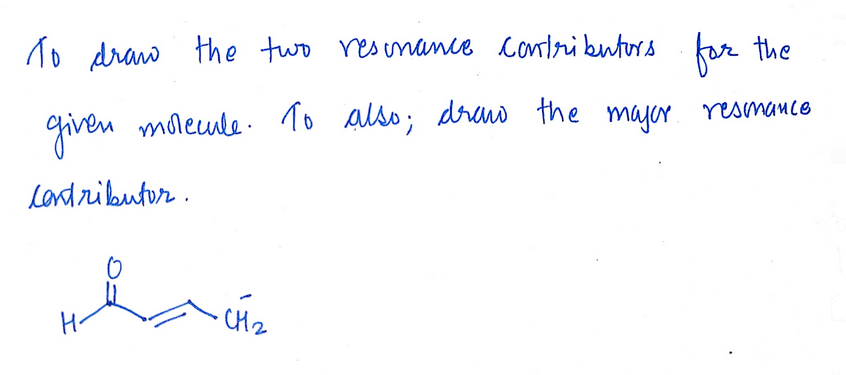
Chemistry
10th Edition
ISBN: 9781305957404
Author: Steven S. Zumdahl, Susan A. Zumdahl, Donald J. DeCoste
Publisher: Cengage Learning
expand_more
expand_more
format_list_bulleted
Concept explainers
Question
![Problem 7.42 (a11)
Part A
There are two resonance contributors for this molecule. Draw the major resonance contributor of the ion shown.
Interactive 3D display mode
H
Draw the molecule on the canvas by choosing buttons from the Tools (for bonds), Atoms, and Advanced Template toolbars, including charges where needed. The single bond is active by default.
NN
CH₂
[1]
A
H 12D EXP.¹ CONT?
L
Marvin JS
by ChemAxon
I L
C
N
O
S
Cl
Br
1
P
LL](https://content.bartleby.com/qna-images/question/62cc748c-628b-4ab0-8610-e208833b302f/c62f7624-78bb-4d9e-af0b-fb53f1e92994/50ueiir_thumbnail.jpeg)
Transcribed Image Text:Problem 7.42 (a11)
Part A
There are two resonance contributors for this molecule. Draw the major resonance contributor of the ion shown.
Interactive 3D display mode
H
Draw the molecule on the canvas by choosing buttons from the Tools (for bonds), Atoms, and Advanced Template toolbars, including charges where needed. The single bond is active by default.
NN
CH₂
[1]
A
H 12D EXP.¹ CONT?
L
Marvin JS
by ChemAxon
I L
C
N
O
S
Cl
Br
1
P
LL
Expert Solution
arrow_forward
Step 1

Step by stepSolved in 2 steps with 2 images

Knowledge Booster
Learn more about
Need a deep-dive on the concept behind this application? Look no further. Learn more about this topic, chemistry and related others by exploring similar questions and additional content below.Similar questions
- 9:35 Back Module 2 Homework.docx (A) For each structure, draw the resonance structure that is indicated by the curved arrows. (Remember formal charges) $5 (B) For each problem below, determine whether the curved arrow violates a rule of drawing resonances structures, and describe the violation, if any. (c) Draw the curved arrow required to convert the first resonance structure into the second & Dashboard Pattern Recognition H₂C-N=N=N e Calendar To Do 34 ₂0 H₂C-N-NEN 5G 11 G Notifications Inboxarrow_forwardNonearrow_forwardanswer d, e and farrow_forward
- Please don't provide handwritten solution...arrow_forwardPlease don't provide handwriting solutionarrow_forward3. Provide at least one significant alternative resonance form for each molecule below. Generate a total of six correct structures to receive credit for this question. Provide curved arrows on the given structure to show how it relates to the first structure you draw in each case. An example is shown below in blue. A. R2N° C. R2N. E. B. D.arrow_forward
- help please answer in text form with proper workings and explanation for each and every part and steps with concept and introduction no AI no copy paste remember answer must be in proper format with all workingarrow_forwardDon't use hand raiting answer please and step by step answer pleasearrow_forwardChoose the resonance structure that results from the arrow pushing scheme below: A H OH Give detailed Solution with explanation needed of all options.don't give Handwritten answerarrow_forward
- For each of the following molecules, draw all the valid resonance formsarrow_forwardhelp please answer in text form with proper workings and explanation for each and every part and steps with concept and introduction no AI no copy paste remember answer must be in proper format with all workingarrow_forward9. Draw all resonance structures of the following compounds. Show electron-pushing arrows.arrow_forward
arrow_back_ios
arrow_forward_ios
Recommended textbooks for you
 ChemistryChemistryISBN:9781305957404Author:Steven S. Zumdahl, Susan A. Zumdahl, Donald J. DeCostePublisher:Cengage Learning
ChemistryChemistryISBN:9781305957404Author:Steven S. Zumdahl, Susan A. Zumdahl, Donald J. DeCostePublisher:Cengage Learning ChemistryChemistryISBN:9781259911156Author:Raymond Chang Dr., Jason Overby ProfessorPublisher:McGraw-Hill Education
ChemistryChemistryISBN:9781259911156Author:Raymond Chang Dr., Jason Overby ProfessorPublisher:McGraw-Hill Education Principles of Instrumental AnalysisChemistryISBN:9781305577213Author:Douglas A. Skoog, F. James Holler, Stanley R. CrouchPublisher:Cengage Learning
Principles of Instrumental AnalysisChemistryISBN:9781305577213Author:Douglas A. Skoog, F. James Holler, Stanley R. CrouchPublisher:Cengage Learning Organic ChemistryChemistryISBN:9780078021558Author:Janice Gorzynski Smith Dr.Publisher:McGraw-Hill Education
Organic ChemistryChemistryISBN:9780078021558Author:Janice Gorzynski Smith Dr.Publisher:McGraw-Hill Education Chemistry: Principles and ReactionsChemistryISBN:9781305079373Author:William L. Masterton, Cecile N. HurleyPublisher:Cengage Learning
Chemistry: Principles and ReactionsChemistryISBN:9781305079373Author:William L. Masterton, Cecile N. HurleyPublisher:Cengage Learning Elementary Principles of Chemical Processes, Bind...ChemistryISBN:9781118431221Author:Richard M. Felder, Ronald W. Rousseau, Lisa G. BullardPublisher:WILEY
Elementary Principles of Chemical Processes, Bind...ChemistryISBN:9781118431221Author:Richard M. Felder, Ronald W. Rousseau, Lisa G. BullardPublisher:WILEY

Chemistry
Chemistry
ISBN:9781305957404
Author:Steven S. Zumdahl, Susan A. Zumdahl, Donald J. DeCoste
Publisher:Cengage Learning

Chemistry
Chemistry
ISBN:9781259911156
Author:Raymond Chang Dr., Jason Overby Professor
Publisher:McGraw-Hill Education

Principles of Instrumental Analysis
Chemistry
ISBN:9781305577213
Author:Douglas A. Skoog, F. James Holler, Stanley R. Crouch
Publisher:Cengage Learning

Organic Chemistry
Chemistry
ISBN:9780078021558
Author:Janice Gorzynski Smith Dr.
Publisher:McGraw-Hill Education

Chemistry: Principles and Reactions
Chemistry
ISBN:9781305079373
Author:William L. Masterton, Cecile N. Hurley
Publisher:Cengage Learning

Elementary Principles of Chemical Processes, Bind...
Chemistry
ISBN:9781118431221
Author:Richard M. Felder, Ronald W. Rousseau, Lisa G. Bullard
Publisher:WILEY